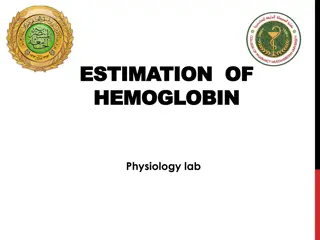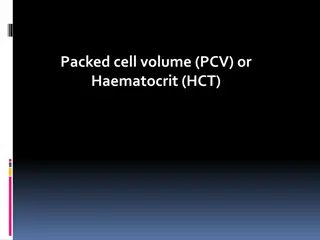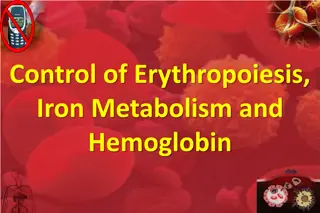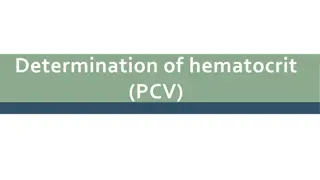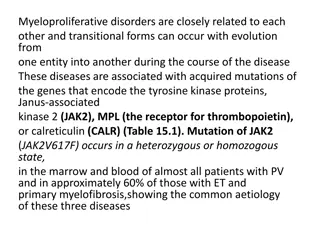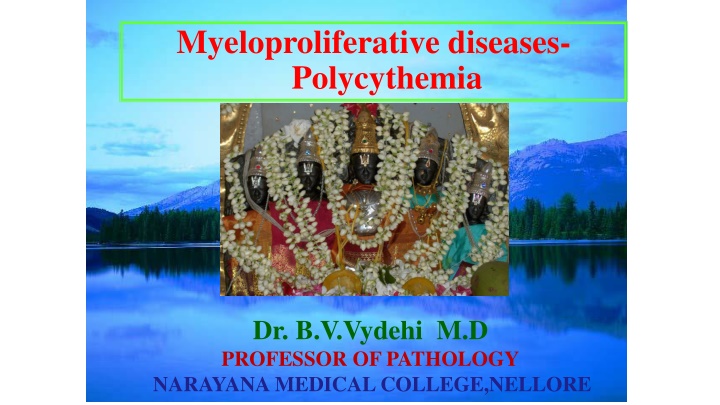
Polycythemia Vera: Symptoms and Classification
Explore the world of Polycythemia Vera with detailed insights into its classification, clinical features, and pathophysiology. Learn about the different types of Polycythemia, including Polycythemia rubra vera and secondary Polycythemia, along with relative Polycythemia. Discover the clinical manifestations such as skin and mucous membrane changes, aquagenic pruritus, erythromelalgia, headaches, dizziness, and gastrointestinal symptoms associated with Polycythemia Vera. Gain knowledge about the pathophysiological aspects, including the molecular defects, serum erythropoietin levels, and abnormal growth factors in Polycythemia Vera.
Download Presentation

Please find below an Image/Link to download the presentation.
The content on the website is provided AS IS for your information and personal use only. It may not be sold, licensed, or shared on other websites without obtaining consent from the author. If you encounter any issues during the download, it is possible that the publisher has removed the file from their server.
You are allowed to download the files provided on this website for personal or commercial use, subject to the condition that they are used lawfully. All files are the property of their respective owners.
The content on the website is provided AS IS for your information and personal use only. It may not be sold, licensed, or shared on other websites without obtaining consent from the author.
E N D
Presentation Transcript
Myeloproliferative diseases- Polycythemia Dr. B.V.Vydehi M.D PROFESSOR OF PATHOLOGY NARAYANA MEDICAL COLLEGE,NELLORE
Polycythemia Vera Neoplasm of multipotent myeloid stem cell, characterized by : (i) marrow production of erythroid, granulocytic and megakaryocytic elements (ii) Peripheral blood erythrocytosis (Polycythemia), granulocytosis and thrombocytosis
Classification of Polycythemia (Erythrocytosis) I. Polycythemia rubra vera (Primary- Neoplastic) II. Secondary Polycythemia (Reactive Erythrocytosis) a. Appropriate erythropoietin production (Tissue hypoxia) Eg: High attitude, obesity, (Pickwickian syndrome), COPD, Cyanotic heart disease b. Inappropriate erythropoietin production Eg: Erythropoietin producing tumors (RCC, HCC, Cerebellar hemangioblastomas) c. Familial erythrocytosis Eg: Hemoglobins with high oxygen affinity
Classification of Polycythemia (Erythrocytosis) III. Relative (Spurious) Polycythemia (RCM & Hematocrit remain normal) Eg: - Dehydration - Burns - Shock - Gaisbock s syndrome (Stress polycythemia): Hypertensive, obese, nervous males of > 40 yrs with H/O smoking & Alcoholism
Polycythemia Vera-Pathophysiology Causative molecular defect is unknown Serum erythropoietin levels in P.V very low; In other forms of polycythemia erythropoietin levels Presence of abnormal growth factors that act on normal stem cells Cytogenetics : Trisomy 8, Trisomy 9 & deletion of Y, 5q, 6q, 7q, 11q, 13q & 20q
Polycythemia Vera-Clinical features Skin & mucus membranes Plethora : Color of face is ruddy, esp. lips, cheeks, tip of nose, ears & neck Aquagenic pruritis : Intense itching after exposure to water - This may be initial presentation of PV - Seen in 60% of pts. under age 40 Erythromelalgia: - Reddening, swelling & pain in digits - Ass. with extreme platelet elevations
Polycythemia Vera-Clinical features Headache, dizziness, visual disturbances Gastrointestinal symptoms (Peptic- ulcers, bleeding ect.,) Atherosclerotic heart diseases, hypertension, IHD etc., Symptomatic gout in 5 to 10 % of cases Risk of bleeding & thrombotic episodes
PV - Morphology Blood : Hb : 18 to 24 g/dl R.B.C : 7 to 10 million/cumm Moderate to marked leucocytosis with Shift to Left in myeloid series Platelets : 5 to 10 lakhs/ cumm BM : Hypercellular bone marrow Number of erythroid, myeloid precursors & megakaryocytes
Bone marrow aspirate in polycythaemia rubra vera showing marked hypercellularity and increased megakaryocytes
Other Laboratory Findings Viscosity of blood : 5 to 8 times greater than normal Serum uric acid N or Extramedullary hematopoiesis in spleen& liver (Organomegaly)
Polycythemia Vera Study Group Diagnostic Criteria Major Criteria Significance M1 Red cell mass males >36 ml/kg Females >32 ml/kg M2 Arterial O2 Saturation > 92 % Identifies actual polycythemia Vs spurious polycythemia Rules out most common cause of sec polycythemia E/O Myeloproliferative state M3 Splenomegaly or 2 of minor criteria
Polycythemia Vera Study Group Diagnostic Criteria Minor criteria: m1 Thrombocytosis > 4.0 lakhs/cum m2 Leucocytosis > 12,000 /cumm m3 LAP Score > 100 m4 Serum B12 > 900 pg/ml (or) Unsaturated B12 binding capacity > 220 pg/ml Criteria essential for Diagnosis: Presence of all 3 major criteria (or) First 2 major& 2minor criteria
Polycythemia Vera-Natural History With out treatment 18 months With phlebotomies alone 10 yrs 15 to 20 % Myelofibrosis AML transformation - 2 % (treatment with phelebotomy alone) - 5 % (treatment with myelosuppressive therapy)

